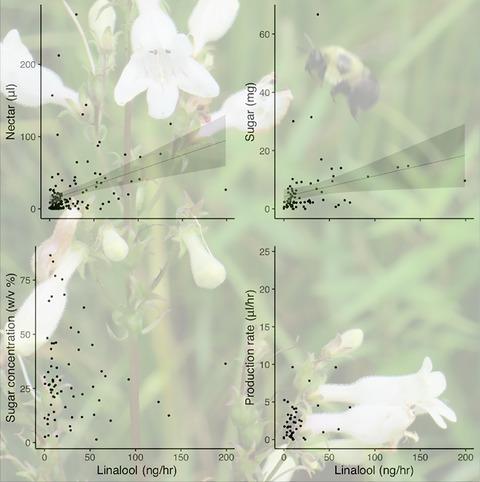Our official English website, www.x-mol.net, welcomes your feedback! (Note: you will need to create a separate account there.)
Scented nectar and the challenge of measuring honest signals in pollination
Journal of Ecology ( IF 5.5 ) Pub Date : 2020-05-23 , DOI: 10.1111/1365-2745.13432 Rosalie C. F. Burdon 1 , Robert A. Raguso 2 , Robert J. Gegear 3 , Ellen C. Pierce 3 , André Kessler 4 , Amy L. Parachnowitsch 1, 5
中文翻译:

花蜜和授粉中测量诚实信号的挑战
更新日期:2020-05-23
Journal of Ecology ( IF 5.5 ) Pub Date : 2020-05-23 , DOI: 10.1111/1365-2745.13432 Rosalie C. F. Burdon 1 , Robert A. Raguso 2 , Robert J. Gegear 3 , Ellen C. Pierce 3 , André Kessler 4 , Amy L. Parachnowitsch 1, 5
Affiliation

|
- Nectar scents are thought to function as honest signals of reward used by pollinators, but this hypothesis has rarely been tested.
- Using Penstemon digitalis, we examined honest signalling of the nectar volatile (S)‐(+)‐linalool and pollinator responses to linalool in both field and laboratory settings. Because our previous work showed that linalool emission was associated with higher female fitness and that nectar is scented with linalool, we hypothesized that linalool was an honest signal of nectar reward. To assess honesty, we measured linalool–nectar associations including nectar volume, sugar amount, concentration and production rate for inflorescences and flowers in several populations. We also assessed whether Bombus impatiens, the main pollinator of P. digitalis at our sites, can use linalool as a foraging signal. We supplemented real or artificial flowers in the field and laboratory with varying linalool–nectar combinations to measure pollinator behavioural responses.
- We found that an inflorescence's linalool emissions could be used to predict nectar rewards in P. digitalis, but this was driven by indirect associations with display size rather than directly advertising more profitable flowers. For flowers within inflorescences there was also no evidence for an association between signal and reward. Field tests of bumblebee behaviour were inconclusive. However, in laboratory assays, bumblebees generally used variation in linalool emissions to choose more profitable flowers, demonstrating they can detect differences in linalool emitted by P. digitalis and associate them with reward profitability. These results suggest experiments that decouple display size, scent and reward are necessary to assess whether (and when) bees prefer higher linalool emissions. Bees preferred nectars with lower linalool concentrations when linalool flavoured the nectar solution, suggesting the potential for conflicting pressures on scent emission in the field.
- Synthesis. Our results highlight the challenges of assessing function for traits important to fitness and suggest that the perception of floral signalling honesty may depend on whether pollinators use inflorescences or flowers within inflorescences when making foraging decisions. We conclude that future research on honest signalling in flowering plants, as well as its connection to phenotypic selection, should explicitly define honesty, in theoretical and experimental contexts.
中文翻译:

花蜜和授粉中测量诚实信号的挑战
- 花蜜的气味被认为是传粉媒介使用的诚实的奖励信号,但这种假说很少得到检验。
- 我们使用洋地黄Penstemon检验了实地和实验室环境中花蜜挥发物(S)-(+)-芳樟醇和授粉媒介对芳樟醇的诚实信号传递。因为我们以前的工作表明,芳樟醇的释放与较高的女性健康状况有关,并且花蜜带有芳樟醇的香味,所以我们假设芳樟醇是花蜜奖励的诚实信号。为了评估诚实度,我们测量了一些群体中芳樟醇-花蜜的关联,包括花蜜的体积,糖含量,花序和花朵的浓度和生产率。我们也评估是否熊蜂凤仙花,主要传粉P.洋地黄在我们的站点上,可以使用芳樟醇作为觅食信号。我们用不同的芳樟醇-花蜜组合在田间和实验室补充了真花或人造花,以测量授粉媒介的行为反应。
- 我们发现,花序的芳樟醇释放量可用于预测洋地黄中的花蜜奖励,但这是由与显示大小的间接关联而不是直接宣传更具盈利能力的花朵所驱动的。对于花序内的花朵,也没有证据表明信号与奖励之间存在关联。大黄蜂行为的现场测试尚无定论。但是,在实验室分析中,大黄蜂通常使用芳樟醇排放量的变化来选择更有利可图的花朵,这表明它们可以检测出洋地黄假单胞菌释放的芳樟醇的差异。并将它们与奖励盈利能力联系起来。这些结果表明,有必要对显示器的大小,气味和奖励进行分离,以评估蜜蜂是否(以及何时)偏爱较高的芳樟醇排放量。当芳樟醇对花蜜溶液进行调味时,蜜蜂更喜欢芳樟醇浓度较低的花蜜,这表明田间散发气味的压力存在潜在冲突。
- 综合。我们的结果凸显了评估对健身重要性状的功能的挑战,并表明对花信号诚实度的感知可能取决于传粉媒介在做出觅食决策时是使用花序还是在花序内开花。我们得出结论,关于开花植物中诚实信号及其与表型选择的联系的未来研究应在理论和实验方面明确定义诚实性。



























 京公网安备 11010802027423号
京公网安备 11010802027423号